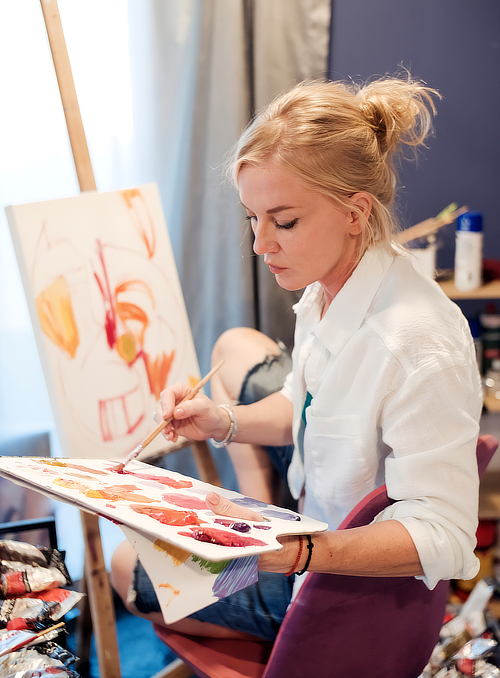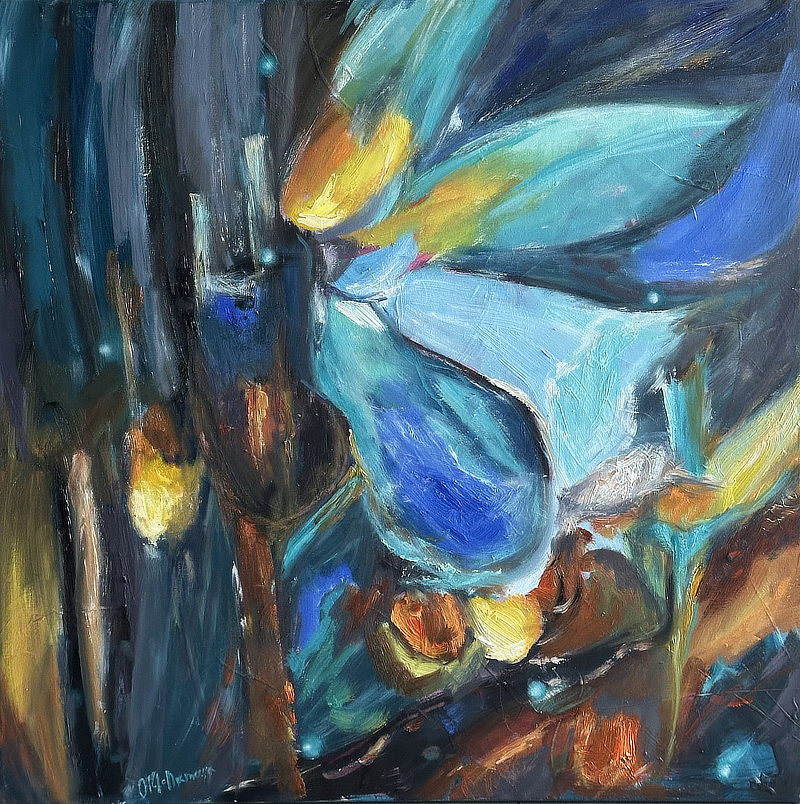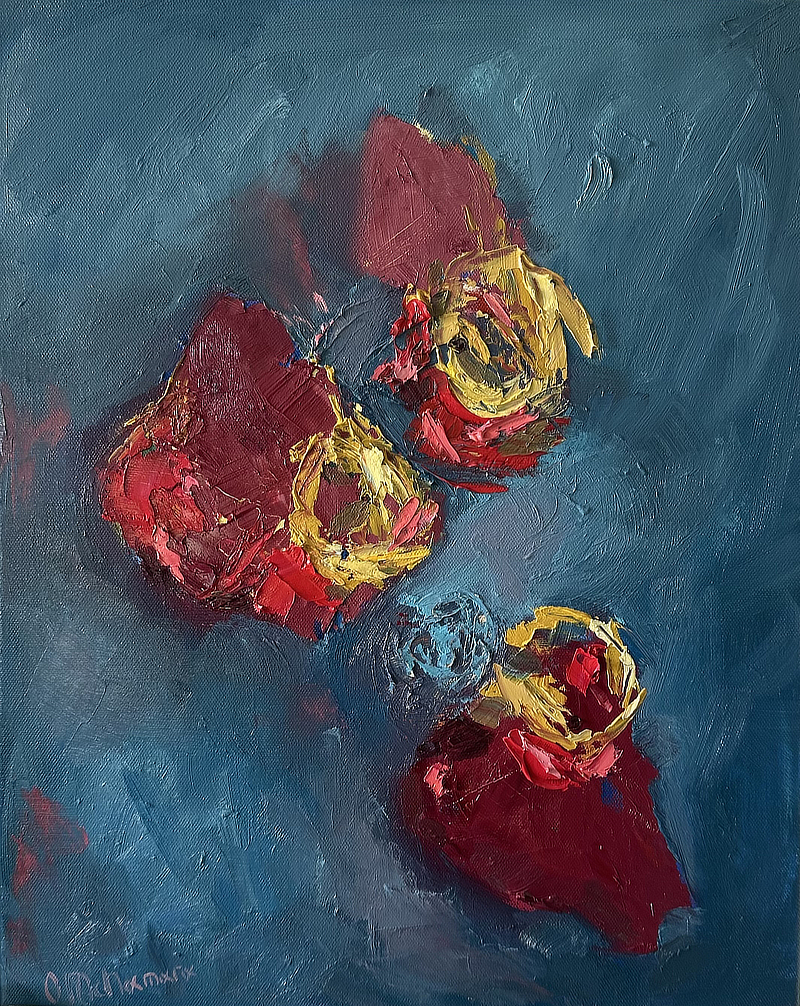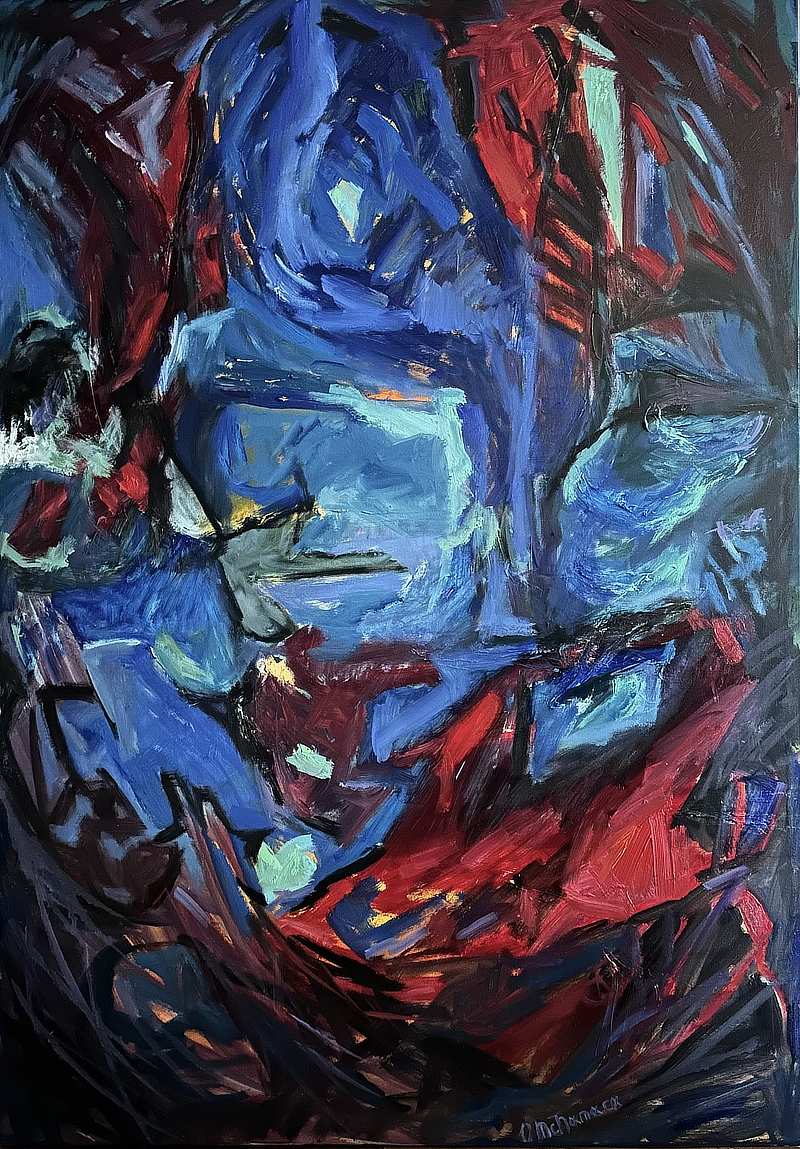
Olga, our gallery has worked with you for the past few years, and we have watched your art develop with interest. Now, you favor more abstract painting. What does this style offer you? How does it benefit your art? What meanings and emotions do you convey in your latest works?
Abstraction allows me to speak the unspeakable—not with symbols or narrative, but with breath, tension, and energy. It’s a language of sensation. Through abstraction, I’m able to go beneath surface reality and reach the deeper emotional undercurrents of a moment, a memory, or even a silence.
At this stage of my artistic life, I consciously avoid storytelling. I’m no longer interested in offering clear explanations or linear meanings. What draws me most is the openness of abstraction—there are no fixed interpretations, only felt truths. The viewer is invited to experience, not decode.

What draws me most is the openness of abstraction—there are no fixed interpretations, only felt truths
Your artistic endeavors span several countries. What does each one contribute to your creativity? What images and emotions are associated with each country?
I carry within me many landscapes and many emotional climates. My work is shaped as much by place as by movement between places.
I was born in Uzbekistan, in a land of desert winds, brilliant textiles, and unspoken depth. There’s a rawness to Central Asia that shaped me early: the palette of sunburnt earth, the silence of big skies, and the deep cultural codes of strength, survival, and poetry.
Later I spent seventeen formative years in Russia, which offered both rigor and contradiction. There I learned the discipline of introspection, the weight of intellectual heritage, and the melancholy of beauty.
I was surrounded by a culture where art, poetry, and thought are taken seriously—where feeling isn’t rushed, and beauty often hides in the quiet. Russia gave me Dostoevsky and Tarkovsky, long winters, and a way of seeing the world that stays with me in everything I paint. Those years taught me not to be afraid of depth or of
stillness.

My ideal is a rhythm between both worlds: online visibility that supports real-world, soulful encounters
Then came Cyprus, a land of searing light and timeless presence.
I often return here to work in solitude. The heat, the whiteness, the stillness of ancient stones—they shift my pace. Cyprus gives me breath. It’s where I slow down, peel away noise, and let the gesture lead.
Ireland, where I live and often show my work, has given me something very special. There’s a quiet strength in this country—a deep connection to the land, to history, to emotion that isn’t always spoken out loud, but is always felt. People here carry things gently, with dignity and a sense of care. I’ve learned a lot just by being in this place—about honesty, about softness, and about standing your ground without needing to shout. The rhythm of the Atlantic, the changing light, the way everything feels alive and meaningful—it all finds its way into my painting, even when I don’t plan it.
Each country becomes a layer in my paintings—not as scenery, but as emotional texture. What ties them together is displacement: the in-between, the crossing. That movement is central to how I create.

How do you promote your work? What is your main focus? How do you evaluate your presence on offline and online platforms?
My main focus is not visibility for its own sake, but resonance—creating moments where the work truly reaches someone. I exhibit in curated shows and international exhibitions, which allow for deep encounters with audiences and curators. I also use online platforms like Zatista, Singulart, Saatchi Art, and Artfinder, which help collectors find my work across borders. These platforms have expanded my reach—my paintings now live in homes across Europe, US and Australia.
Instagram is more than a portfolio for me—it’s a place to share process, fragments, intuition. I don’t aim to entertain, but to build a slow, quiet connection with those who are moved by this language.
That said, nothing replaces presence. Seeing a painting in person—its scale, depth, energy—is a different experience altogether. My ideal is a rhythm between both worlds: online visibility that supports real-world, soulful encounters.
What do you miss about the current structure of the art market?
I miss intimacy—the slow-building relationships between artist, curator, and collector. There’s a growing sense that artists must become marketers, constantly explaining, performing, optimizing. But art isn’t built for that speed. The most meaningful paintings I’ve made came from stillness—from time, from not knowing. I also miss risk in curation. The market often favors what’s safe or already popular. But art that truly touches people often arrives as a surprise—unpolished, uncomfortable, new. I hope we can make more space for that again.
Have you placed your work in non-professional venues such as cafes, restaurants, or offices?
In earlier stages, yes. Sometimes the experience was unexpectedly positive—especially when the space respected the art and allowed it to be more than background. But I’ve also learned that context matters deeply. A painting needs space to breathe, to speak. In the wrong setting, its voice is muffled.
Today I’m more intentional, seeking places where the work can be felt, not just seen.
Do you participate in tenders such as RFPs or RFQs? Could you share your experience?
I’ve taken part in international open calls, biennales, and juried exhibitions, where submission processes sometimes resemble RFPs. I value opportunities that are transparent, purposeful, and aligned with my vision. When the process feels meaningful—when the curators are truly seeking dialogue—I participate. But I’m selective. I choose presence over performance.
What are your next creative plans?
Right now, I’m immersed in a new series called “NIKOMU. Only Me.” It’s a return to pure, internal painting—made without an audience in mind. These works are raw, unresolved, and deeply honest. They’re not meant to impress—they’re meant to release something. Ironically, that’s often when the most powerful paintings emerge. At the same time, I continue developing my relationships with collectors and preparing for future exhibitions. I believe in slow growth—in art as a long conversation, not a sprint. My paintings are not just objects—they’re containers of experience. I want them to live where they are seen, yes—but more importantly, where they are felt.
